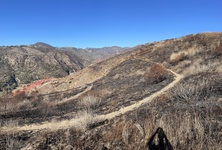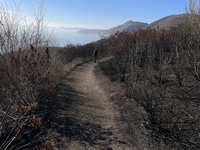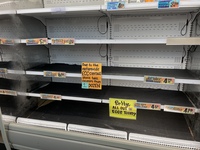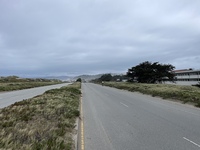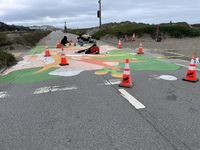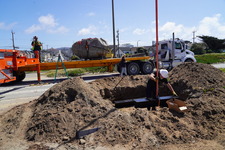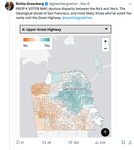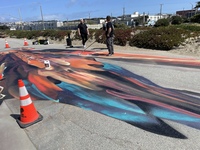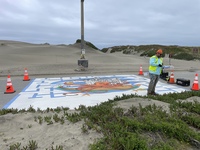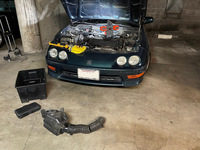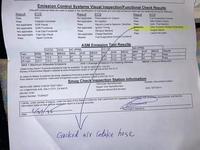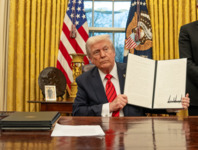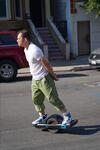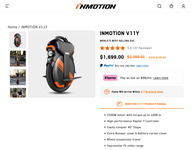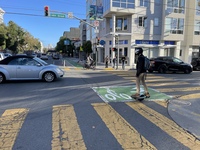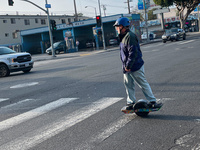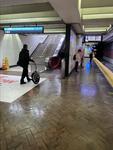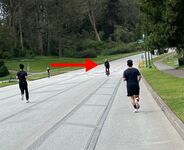 |
| Angelika/Mike Schilli |
Michael Surely you have heard in the news about the devastating wildfires in Los Angeles in January. What you might not know is that we were on vacation there just three days before. We had rented a place in Venice Beach over New Year's and were doing our typical L.A. activities, like dining out, biking along the beach to Santa Monica, and I got to surf. After the waves at Manhattan Beach were too high for me one day, we drove up to just before Malibu to Will Rogers Park, and I paddled out at the pier and caught a few waves. We had no idea that just three days later, the entire area, including my surf beach, would burn down!
And, a few days earlier, on an extremely sunny, almost hot day (in January), we had set out on a hiking trail that led up into the hills through Corral Canyon near Malibu. We marveled at the area, which consisted only of burnt bushes, as a wildfire had raged there several months before.
The red fire retardant that the fire department had sprayed over the area with airplanes to control the flames was still sticking to the withered and scorched plants along the trail. It was an eerie scenario, and we said to ourselves, "No wonder a fire spreads explosively here; those dried-out bushes burn like tinder!" And we had no idea that three days later, just a few hills away, it would actually catch fire, and catastrophically so!
This time, the wildfires destroyed entire towns, like Palisades and vast residential areas along the coast. Even the beach houses along the Pacific Coast Highway now lie in ruins. Wildfires in California are notoriously not uncommon, but the reason it turned into a century catastrophe this time, leaving tens of thousands homeless and transforming the area into a lunar landscape for decades, is the misguided policies of the county. For decades, forestry management was neglected, and funding for the local fire department was cut. Now, tens of thousands of affected people are left uprooted without homes and will have to deal with insurance and insane bureaucratic requirements for rebuilding for years, before they can live there again.
We are certainly glad that we escaped unscathed ahead of time. As part of the sudden evacuation measures, the Pacific Coast Highway, where we were already stuck in traffic during normal times, turned into a death trap, and many people simply abandoned their cars and fled on foot. Television news later reported how bulldozers had pushed the abandoned vehicles off the highway to make room. That would have been a mess for us, my dear!
Angelika In March, I had my birthday. As is well known, birthdays come with cake. However, since eggs are currently in short supply in the USA, we actually had to ration our eggs before my birthday. We skipped our weekend breakfast eggs so that there would be enough left for baking the cake. In the supermarkets here, customers are currently allowed to buy only a certain number of egg cartons. At "Trader Joe's," for example, that's only one carton with 12 eggs per customer per day. However, if customers don't show up first thing in the morning, all they find is empty egg shelves.
It goes without saying that due to the scarcity, the prices for eggs are rising. We already learned this in school about the market economy: The good is scarce, but the demand is high, so the price goes up. In San Francisco, the average price for a dozen eggs is currently a hefty $9. "Trader Joe's" is one of the few supermarket chains that hasn't raised their egg prices exorbitantly yet. There, customers can still get a carton of eggs for $5. However, because of this, the shelves are always particularly quickly emptied. Some restaurants are already adding a surcharge to egg-heavy dishes, such as the chains "Waffle House" and "Denny's."
But why are eggs scarce here in the USA? An outbreak of avian flu is the primary reason. Many chickens had to be culled because they carried the virus. Fewer egg-laying chickens now unfortunately produce fewer eggs for sale. Chicken farms in the USA are often quite large, with up to a million chickens per farm. However, if avian flu breaks out, usually all chickens have to be killed to prevent further spread of the virus.
The prices for eggs had already increased due to inflation before the outbreak of avian flu, and new regulations in some states, such as cage-free housing on chicken farms, have exacerbated the shortage. In California, since 2022, egg-laying chickens on chicken farms can no longer be kept in cages and must be given freedom of movement. These rules also apply to egg producers outside of California if their products are imported here. In fact, California voters had approved Proposition 12, the "Farm Animal Confinement Initiative," in 2018 with 63% of the vote, which mandates humane treatment. It has been implemented since 2022. Especially now during Easter, eggs are in the spotlight. But what to do when eggs are scarce? I recently read in the New York Times that some clever folks are switching to alternatives, such as coloring potatoes instead of eggs. Well, to each their own.
Michael Whenever I drive through Germany on vacation, I immediately switch to Defcon One, because it's important to spot all those speed traps in time. Often, an inconspicuous village in the middle of nowhere has installed a stationary camera to cash in on us tourists, and cities like Munich or Augsburg are practically plastered with speed cameras. Not to mention the mobile units that set up speed traps in the most unlikely places.
I never would have thought that such surveillance state methods would take hold here in San Francisco. But our Governor Gavin Newsom signed Assembly Bill No. 645 in 2023, which layed the legal groundwork for the speed cameras. As is well known, the wheels of our city administration turn at a snail’s pace, but by March 2025, all 33 cameras of the "pilot project" had been installed in San Francisco. The mayor and city council inaugurated them with great fanfare under the motto "Speed Safety." So far, only a few of the cameras have been activated, and even those are currently only sending warning notices without fines by mail to drivers. The website of the responsible agency SFMTA shows the current status of all 33 installed traps (Figure 12).
To prevent any caught driver from getting the idea to sue the city, there are large signs a few feet before the cameras indicating the permitted maximum speed and the note "Photo Enforced" (Illustration 13).
The whole setup, of course, has the catch that speeding criminals with stolen cars won't ever pay any fines. And, typical for San Francisco, a two-tier legal system applies: average earners are punished twice as harshly as poor people, because speeding low-income earners officially receive a 50% discount (Figure 14).
From the table in Figure 14, you can see that the grading was obviously determined by someone who has never driven a car before. The fine for a kamikaze speeder who races through the city at over 100 mph (160 km/h) is only $500, or just $250 for those with low income! As mentioned, no fines have been issued yet.
According to a study by the city's transportation authority SFMTA (San Francisco Municipal Transportation Agency), 42,210 drivers per day exceeded the permitted maximum speed by more than 11 miles per hour, and another 7,000 were caught driving 16 to 25 miles per hour over the limit. And apparently, they only took measurements at one of all 33 camera locations! Now, the laws of the state of California require that the authority cannot automatically send out fines. Each ticket must be manually reviewed by an employee. With two minutes of review time per ticket, that would provide bread and work for about 200 new city employees. And the city urgently needs an economic miracle!
Unlike speed cameras in Germany, the new cameras in San Francisco do not identify the driver but only the license plate of the speeding vehicle. The ticket is then sent to the vehicle's DMV registered owner. If the owner then feels they are not responsible, they can file a written objection and name the actual driver. This seems legally shaky to me, but it is supposedly permissible since it only involves civil law violations. The caught speeders will pay fines to the city, but won't receive any points on their record. Additionally, nothing is reported to the vehicle owner's insurance, unlike with police-issued fines.
San Francisco's Upper Great Highway Becomes Car-Free 'Sand Dunes Park'
Angelika Did you know that in San Francisco, the coastal road along Ocean Beach has recently been closed to cars? Here's how it happened: During COVID, the city's transportation department in San Francisco came up with the brilliant idea of establishing so-called "Slow Streets," which are traffic-calmed roads where pedestrians and children on bicycles could spread out (Rundbrief 09/2020), so you didn't feel so confined. "Slow Streets" still allowed access for residents and delivery people. They were not completely closed to cars. The program was so popular in San Francisco that some "Slow Streets" were kept that way even after the pandemic, such as Sanchez Street around the corner from us, which we still frequently use for our walks.
San Francisco is famously located by the Pacific Ocean and has several beaches in the western part of the city. "Ocean Beach" is the longest. Directly adjacent to "Ocean Beach" is the "Great Highway," a four-lane access road. "Highway" sounds somewhat grandiose because it brings to mind German autobahns. However, in the USA, "highways" generally refer to roads that can vary greatly in width and development. A "freeway" is more akin to a generously designed autobahn. I would describe the "Great Highway" more as a larger city street that, as mentioned, runs along the ocean beach.
The street has only a few traffic lights, and drivers make good progress. In April 2020, during the pandemic, the city closed a two-mile (3.2 km) section of the Great Highway, the so-called "Upper Great Highway," between Lincoln Avenue and Sloat Boulevard, so that the public could engage in physical activities there. This closure was also very popular, and no cars were allowed to drive on this section.
At the beginning of the pandemic, this was not a problem at all, as many people were working from home and traffic was light. Residents simply diverted to the neighborhood streets. But soon, voices grew louder to lift the closure. Supporters faced off against those residents who were annoyed by the traffic on the side streets with stop signs at every intersection. And lo and behold, in our city, where compromises are rare and everything is always debated and contested passionately and intensely, an agreement was reached in August 2021. The section remained closed to car traffic from Friday afternoon through the weekend and on public holidays. However, on weekdays, cars were allowed to speed through. Everyone had to give a little, but each side also got something they wanted.
In English, that's called a "win-win situation." This could have put the issue to rest, but wait, that would be too easy. The compromise that was worked out was limited as a pilot project and was set to expire at the end of 2025. The city wanted to collect data to see how much the closed section was used by pedestrians and cyclists, and what the impact was on traffic flows. I have no idea why the data collection took four years, but such things are not unusual in this city. Instead of properly evaluating the data and then deciding at city council whether the pilot project could continue as is or if changes needed to be made, they preferred to rely on the tried-and-true method of voter referendum through a so-called proposition. Five city representatives and our then-mayor, London Breed, pushed that Proposition K was on our ballot in November 2024, coinciding with the mayoral election in this city, and therefore a high voter turnout was expected.
An intense battle immediately erupted between supporters and opponents of the measure. Now you must know that these propositions are often tricky, because at first glance everything sounds just great. However, when you delve into the details, which only a few voters do, it looks quite different. Proposition K, for example, promised that not only would the 2-mile section be permanently closed to car traffic, but the road would be completely transformed into a park. Of course, everyone generally wants a nice new park right by the sea. What would be an argument against that? But Proposition K only promised the park, without plans for its financing or even ideas for its design.
Additionally, the Great Highway already faced challenges with large sand drifts several times a year due to its proximity to the ocean and the beach, and anyone planning a park should have taken this into account. On election day in November, 54% of citizens voted in favor of Proposition K, and as a result, the "Upper Great Highway" has been permanently closed to all vehicle traffic since March 14 of this year. Interestingly, most of the "no" votes for Proposition K came from the districts bordering the ocean, namely the "Outer Richmond" and "Sunset" neighborhoods. This is not surprising, as the people living there are the most affected by the closure in their daily lives.
Many of the neighborhood residents found it unfair that their voices didn't carry more weight. Consequently, there were efforts to recall city council member Joel Engardio, who represents the Sunset District and had advocated for the highway closure and the park. This is a common strategy among the politically dissatisfied in this city and in California in general. Nevertheless, the same Joel Engardio officially opened the new park in mid-April, now officially named "Sunset Dunes Park."
Currently, this only means that a few artworks have been painted on the street. Sculptures and fitness equipment are supposed to follow. Art is always good. Otherwise, the city plans to use the funding from the California Coastal Conservancy, one million dollars, to explore how the new park will affect traffic and the environment. It will also be examined how the potential rise of the sea level might, in turn, impact the park. Ahhh, we've been here before.
In any case, Michael, who is an enthusiastic cyclist, has scouted out a bicycle loop route from our home in Noe Valley to the close section of the Great Highway. The route first goes down through the Glen Park neighborhood, then through City College, through the University of San Francisco campus, then along the highway, up to Golden Gate Park and back through the park, onto the so-called 'Wiggle', to return through the Mission back to Noe Valley. It takes about two hours.
Michael I have often expressed in this publication that there is no equivalent to the German TÜV (Technical Inspection Association) in America. Some states really allow any vehicle on four wheels to drive on the highways, but California tends to overregulate in this area as well. Every registered motor vehicle must pass the so-called smog test every two years (older vehicles even every year).
Recently, I learned firsthand that the smog test not only evaluates the exhaust gases escaping from the tailpipe. The inspector also goes through a checklist with at most a peripheral connection to the car's emissions. For example, the gas cap must seal airtight; if it doesn't, the onboard computer will display an error message, and the emissions inspector will refuse to give the stamp.
Recently, it happened to me when I cheerfully drove our aging Acura Integra, affectionately called "Rocket," to the smog center and, to my great astonishment, learned that our car had failed the smog test. I knew that in California, you can't continue to register a car without passing the smog test, and a slight unease set in. However, I found out that our Rocket hadn't exceeded the permissible emission levels; instead, a manual inspection of the engine compartment by the smog technician had discovered a crack in the hose to the air filter.
Such a small flaw should, of course, be fixed sooner than later, even with a 27-year-old car with 300,000 kilometers on the clock, because otherwise, the engine will suck in dust particles instead of filtered air, and ruin its interior. But honestly, I was surprised to learn that the smog inspector has TÜV-like authority when it comes to identifying defects. Anyway, I set about repairing the hose and, to my utter astonishment, also discovered that the spare part was no longer available by the manufaturer or 3rd party providers, and was only sporadically traded on eBay at astronomical prices, even as a pre-owned part.
Now, one must know that Japanese cars from the 1990s are still considered popular racing machines among young speedsters in San Francisco. Our model, an Acura Integra GSR, continues to enjoy lively interest in the "Fast and Furious" tuning scene. With only 170 horsepower, the vehicle, reminiscent of an Opel Manta, may not be exciting by today's standards, but it produces an infernal Formula One howl at 8000 revolutions per minute, just before the red zone begins. Smart cookie that I am, I ordered an intake manifold for race cars from a tuning parts supplier and installed it in place of the regular air filter.
That went relatively smoothly after I had to rearrange some hoses in the engine compartment due to space constraints, from which coolant aggressively gushed out when I unplugged them. Now we have a brand-new racing air filter in a 27-year-old engine. When I went to the smog guy for the (free) retest, all the emission values were again within legal limits, and he waved me through. I had made sure to buy a $200 filter that had the California certification (CARB). The part would have only cost $50 in other states. Thank you, California!
Recently, when I went to get an oil change, the mechanic immediately waved his colleagues over to show them the new part in the engine compartment. And our car now sounds normal when idling, but at higher speeds, it makes a noise that makes other drivers immediately take notice and respectfully move to the right lanes. That's how it should be. It's funny what unexpected side effects government overregulation can produce.
Angelika We already know that you are eagerly waiting to hear how things are going for us in Trumphausen. As expected, there is such a mess and chaos that it's hard to keep up. Tariffs up and down. Stock market up and down. Visas are revoked and then reinstated. People in government agencies are fired and then rehired because it turns out that certain positions cannot be left vacant. The speed at which changes are being introduced and pushed through with brute force is surprising and surely intentional, as so many things are happening simultaneously that even seasoned journalists and political observers can't keep up. Meanwhile, as an ordinary citizen, you still have to manage your daily life.
Through the German press, you are surely quite well informed about what is currently happening in the USA, but I wanted to shed light on particular processes that I have long considered a major problem. The USA claims to be a solid democracy with a firm separation of powers, where all three branches--namely the executive, legislative, and judicial--are equal, independent, and subject to mutual control ("checks and balances"). However, there are some very large loopholes that undermine this system and have not been closed so far because everyone has relied on the assumption that no one would ruthlessly exploit these loopholes.
As one of the largest and, in my opinion, most undemocratic excesses I see is governing by decrees, so-called "Executive Orders." These are presidential directives that come into effect without the approval of Congress--as an instrument originally intended to ensure the efficiency of the executive branch, but today increasingly used as a tool to bypass the legislature. Although all presidents have used this method so far, Donald Trump is really taking it to the extreme in his second term, even though he has a - albeit narrow - majority of his Republican Party in both houses. By the way, Joe Biden signed 162 decrees during his term, Barack Obama signed 277 in eight years, and Bill Clinton issued 364 in the same eight-year period. Donald Trump issued 220 Executive Orders in his first term--and in his second term, he is already at 103. Franklin Roosevelt holds the record so far with an incredible 3,721 executive orders, including 2,023 between 1937 and 1945 alone — that is, during World War II.
In my opinion, decrees should only be used in absolute emergencies, such as a natural disaster or pandemic, to allow for swift action. Instead, democratic processes are being undermined to avoid the effort of passing laws. Interestingly, the term "Executive Order" does not appear in the American Constitution. The legal basis is usually Article II, which grants the President executive power--with the obligation to "ensure that the laws are faithfully executed," although this is a very vague formulation. Decrees must not violate existing laws and are not considered laws themselves. This leads to what we are currently experiencing. There is an increase in lawsuits challenging the legality of these decrees. And, since decrees are not laws, any new president can immediately revoke them, which happens regularly.
Another problem I see is with unrestricted pardons that a president can issue with a stroke of a pen. This should only happen in absolute exceptional cases. However, it has become customary for presidents to quickly pardon various individuals just before the end of their term. Often, humanitarian considerations are not the main focus, but rather their own political or familial connections. For example, Bill Clinton pardoned Marc Rich in 2001, who had fled to avoid prosecution for tax evasion and fraud. His wife had donated large sums to the Democratic Party and Clinton's library. Gerald Ford pardoned Richard Nixon in 1974 for possible crimes during his presidency, after Nixon resigned due to the Watergate scandal. I was particularly disappointed that Joe Biden pardoned his son Hunter Biden, even though he had previously insisted that he would never consider doing so. I also find it absolutely absurd that he pardoned some family members prophylactically, even though there were no convictions. It seems no one has integrity anymore. Everyone looks out for themselves and justifies their own misconduct with that of others. Trump then issued blanket pardons to all those convicted for storming the Capitol on January 6, without distinguishing who had committed acts of violence. Some of those pardoned are already back in prison for new offenses.
The American Constitution grants the President extensive powers regarding pardons in Article II, Section 2: "The President shall have the power to grant reprieves and pardons for offenses against the United States, except in cases of impeachment." What does this mean exactly? The President can grant full pardons, commutations, and reprieves without needing the approval of Congress or the courts. However, these pardons only apply to federal offenses and not to crimes at the state level, for which the individual governors of the states are in charge. As mentioned, impeachment cases are also excluded.
The Supreme Court then made a consequential ruling in July 2024 regarding the criminal immunity of the President. The court decided by a vote of 6 to 3 that a (former) President enjoys at least a presumed immunity for actions related to their official duties. This means that prosecution is only possible if it is proven that the charge does not impair the constitutional function of the President. For certain areas, such as the appointment of officials or the exercise of the pardon power, there is even absolute immunity, meaning the President cannot be criminally prosecuted for these actions at all. There is no immunity for private and non-official actions. Therefore, in these cases, courts must first determine whether the matters are official or private.
And then, in a modern democracy, perhaps care should be taken to ensure that ancient laws that are still officially in force are not suddenly dug up. For example, the Trump administration is currently basing deportations to El Salvador on the Alien Enemies Act of 1798, which allows the president to detain or deport citizens of so-called enemy nations without a court trial during a state of war. The application of the law was justified by declaring the Venezuelan gang "Tren de Aragua," which operates on American soil, as a hostile entity.
I'm waiting for us to maybe hear something from the members of Congress every now and then. There's really almost complete silence. Do they not want to govern anymore? The opposition hasn't reorganized yet either, and the Democratic Party is still licking its wounds and coming up with old, outdated ideas. Time is running out, let's get going.
Michael Who hasn't noticed that nowadays even older grandpas are zipping through city streets on e-bikes as if they've been stung by a tarantula, and turning even remote forest trails into death traps?
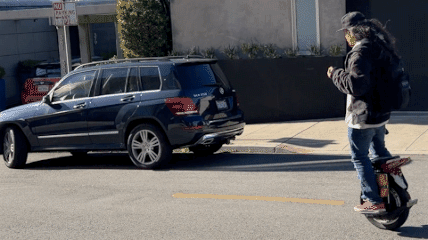
|
| These unicycles can travel up to 30 mph. |
Electromobility is taking increasingly bizarre forms here. First came the e-bikes, where you still had to pedal a bit to get some boost from the battery. Then came these murderously fast moped-like machines, which really only differ from a motorcycle that requires a license in that they don't make any noise while speeding down the street. And, of course, the skateboards with electric motors, often spotted as a form of hipster transportation. And they all crowd onto the narrow bike paths of the city. Classic cyclists duck their heads in fright.
And finally, there are what I call "suicide machines," e-motorized unicycles, either as a board on a thick rubber roller or with a wheel the size of a folding bike, through the hub of which a rod passes, with two footrests on the left and right. The rider stands on it, and like a Segway, the device balances itself while the rider propels it forward by leaning forward or slows it down by leaning back.
I have already seen with my own eyes how lunatics on these electric unicycles have raced through the dense city traffic at surely 30 miles per hour, weaving between cars stuck in traffic, and seemingly completely ignoring the fact that one in a hundred cars could change lanes any point in time and send the daredevil flying high into the air like Evil Knievel.
The problem is not the unicycle itself, as cyclists also survive in city traffic, but rather the extreme speed of these vehicles. The speeding is not legal; the maximum allowable speed in California is 15 mph (24 km/h). Nevertheless, there are shops here in San Francisco that sell souped-up vehicles that go twice as fast.
To ensure the store is on the safe side legally, it sells the part with a switch that, in its normal position, limits the vehicle's speed to the legal requirement. However, the customer can then flip the switch on their own and zoom around at double the speed. Of course, this is illegal, but our police do not (yet) check for such things.
Greetings from our crazy country!
Michael und Angelika


